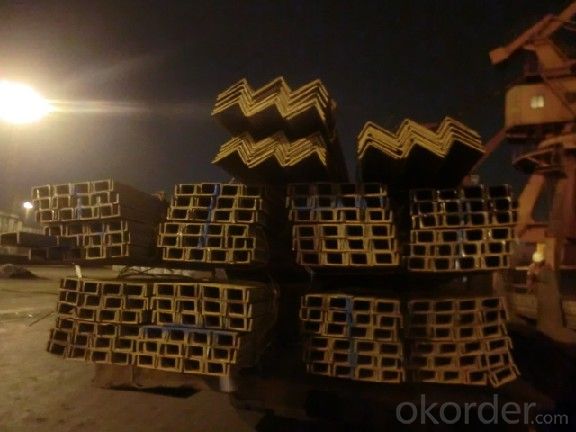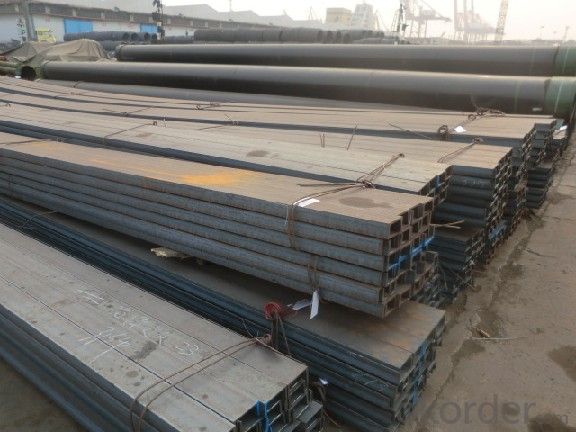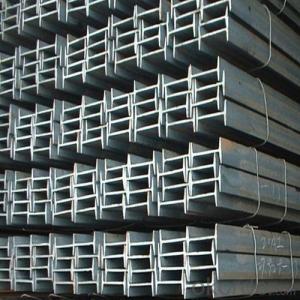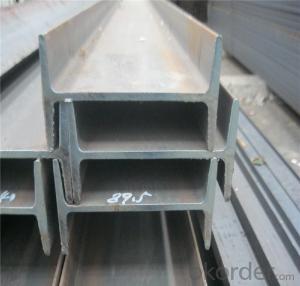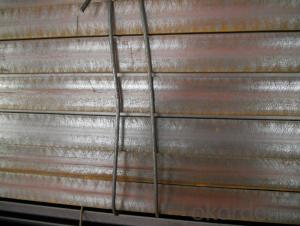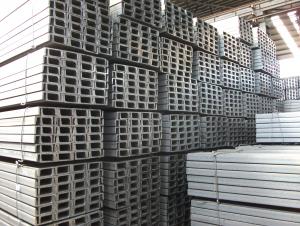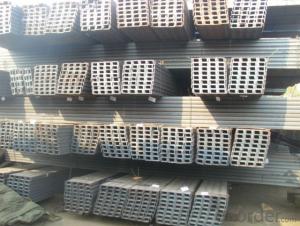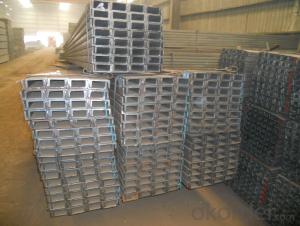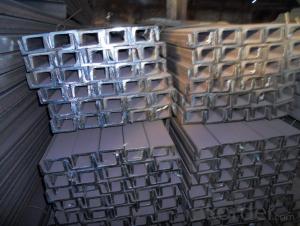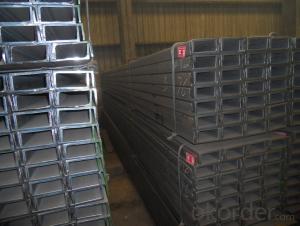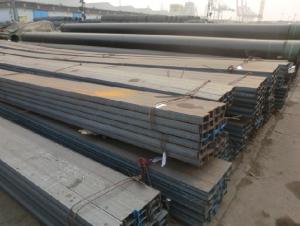Hot Rolled Steel U-Channel with Many Standard
- Loading Port:
- Tianjin
- Payment Terms:
- TT OR LC
- Min Order Qty:
- 20 m.t.
- Supply Capability:
- 1000 m.t./month
OKorder Service Pledge
OKorder Financial Service
You Might Also Like
Product Description:
OKorder is offering Hot Rolled Steel U-Channel at great prices with worldwide shipping. Our supplier is a world-class manufacturer of steel, with our products utilized the world over. OKorder annually supplies products to European, North American and Asian markets. We provide quotations within 24 hours of receiving an inquiry and guarantee competitive prices.
Product Applications:
Hot Rolled Steel U-Channel can be applied to construction of warehouses, workshops, sport stadiums and car parks etc.The hot rolled channel steel belongs to carbon structural steel which is applied to in the field of construction and machinery.In details, the hot rolled channel steel is usually used for arch-itechtural structure, and they could be welded in order to support or hang a vari-ety of facilities. They are also usually used in combination with I beam. Generally,the hot rolled channel steel we supply must possess perfect welding property, riveting property and mechanical property and so on.
Product Advantages:
OKorder's Hot Rolled Steel U-Channel are durable, strong, and resist corrosion.
Main Product Features:
· Premium quality
· Prompt delivery & seaworthy packing (30 days after receiving deposit)
· Corrosion resistance
· Can be recycled and reused
· Mill test certification
· Professional Service
· Competitive pricing
Product Specifications:
We supply high quality MS Channel at reasonable price, including Chinese standard, Japanese standard and so on.
Standard | GB/JIS |
Material Grade | Q235,SS400 |
Technique: | Hot Rolled |
Sizes as per chinese standard: | 50*37*4.5mm - 300*89*11.5mm |
Sizes as per japanese standard: | 50*25*3mm – 200*80*7.5mm |
Length: | 6meter, 9meter, 12meter |
Note: 1.we are also competent to provide our customers other MS Channel based on other sizes according to customer’s requirements.
2. The length of our ms channel could be cut into other meters as per customer’s requirements. For example, the channel in 6meters could be cut into 5.8meters in order to be fit in the 20ft container.
FAQ:
Q1: Why buy Materials & Equipment from OKorder.com?
A1: All products offered byOKorder.com are carefully selected from China's most reliable manufacturing enterprises. Through its ISO certifications, OKorder.com adheres to the highest standards and a commitment to supply chain safety and customer satisfaction.
Q2: How do we guarantee the quality of our products?
A2: We have established an advanced quality management system which conducts strict quality tests at every step, from raw materials to the final product. At the same time, we provide extensive follow-up service assurances as required.
Q3: How soon can we receive the product after purchase?
A3: Within three days of placing an order, we will begin production. The specific shipping date is dependent upon international and government factors, but is typically 7 to 10 workdays.

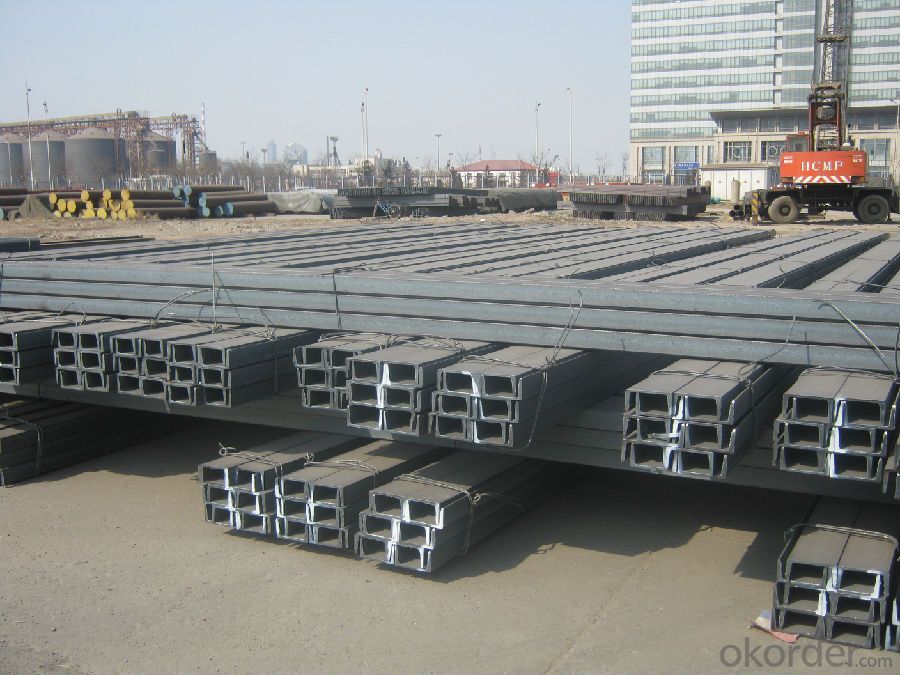
- Q: How many meters is I-beam one?
- The length of I-beam is not specified, but the I-beam height, leg width and waist thickness of each specification are required.
- Q: Can steel I-beams be used in modular construction?
- Yes, steel I-beams can be used in modular construction. They provide a strong structural support system and can be easily integrated into modular building designs.
- Q: What are the different load types that steel I-beams can withstand?
- Steel I-beams can withstand various load types, including dead loads, live loads, and wind loads. Dead loads refer to the weight of the structure itself, as well as any permanent fixtures or materials. Live loads are dynamic loads caused by occupants, furniture, or any temporary loads that may be imposed on the structure. Wind loads, on the other hand, are forces exerted by wind that can vary in magnitude and direction. Steel I-beams are designed to handle these different load types and provide structural support and stability.
- Q: Can steel I-beams be used in curved structures?
- Curved structures can indeed utilize steel I-beams. Although I-beams are typically employed in straight applications, they can be flexed to accommodate the design specifications of a curved structure. This involves a method called cold-bending, where the I-beam is gradually shaped to the desired form using specialized machinery. Through cold-bending, steel I-beams can take on various radii and curves, thus rendering them appropriate for employment in curved structures like arches, domes, and curved roofs. It is pertinent to mention that the bending process may lead to some deformation or distortion in the I-beam's cross-section. Nevertheless, this can be mitigated by implementing proper techniques and ensuring the structural soundness of the curved steel I-beams.
- Q: How do steel I-beams contribute to the overall architectural design of a structure?
- Due to their exceptional strength, versatility, and load-bearing capabilities, steel I-beams play a crucial role in the overall architectural design of structures. The beams form the framework of the building and distribute weight and forces, ensuring stability and integrity. An important contribution of steel I-beams to architectural design is their ability to span long distances without excessive support columns or walls. This allows for open and flexible floor plans, creating vast and unobstructed spaces. By reducing the need for interior load-bearing walls, architects have more freedom to design layouts that meet specific needs. Steel I-beams also provide structural support for multi-story buildings, enabling architects to design taller structures with greater height and verticality. This is especially beneficial in urban environments with limited space, as it allows for efficient land usage by building upward. The strength and rigidity of steel I-beams make it possible to construct skyscrapers and high-rise buildings that can withstand various forces. In addition to their structural functionality, steel I-beams contribute to the aesthetic appeal of structures. Their sleek and minimalistic design adds a modern and industrial touch to architectural styles, which is highly desired in contemporary design. The clean lines and open spaces created by I-beams can be used to emphasize architectural features, showcase views, or create visual effects. Furthermore, steel I-beams are versatile in their application, allowing architects to incorporate them into various design elements. They can be exposed and visible, becoming an integral part of the building's aesthetic. Alternatively, they can be concealed within walls, floors, or ceilings, providing a hidden structural support system that maintains design integrity and maximizes usable space. Overall, steel I-beams are essential for architectural design, contributing to the overall strength, flexibility, and aesthetic appeal of structures. Their ability to bear heavy loads, span long distances, and create open spaces make them a preferred choice for architects aiming for both structural and design excellence.
- Q: What are the different types of steel I-beam support systems?
- There are several types of steel I-beam support systems, including rolled or wide-flange beams, welded or built-up beams, and composite beams. Additionally, there are different variations and configurations of these support systems depending on the specific application and structural requirements.
- Q: What are the different types of steel I-beam connections for beam-to-beam joints?
- There are several different types of steel I-beam connections that can be used for beam-to-beam joints. Some of the most common types include: 1. Welded connections: This involves welding the two beams together at the joint. It provides a strong and rigid connection, but requires skilled labor and can be time-consuming. 2. Bolted connections: This method involves using bolts and nuts to secure the beams together at the joint. It is easier to assemble and disassemble compared to welded connections, but may not provide as much rigidity. 3. Riveted connections: This traditional method involves using rivets to connect the beams. Although it is less commonly used nowadays, it provides a strong and durable connection. 4. Moment connections: These connections are designed to transfer bending moments between the beams. They are typically used in situations where the beams are subjected to heavy loads and require additional support. 5. Shear connections: These connections are designed to transfer shear forces between the beams. They are commonly used in situations where the beams are subjected to lateral loads or wind forces. 6. Slotted connections: This type of connection involves using slots in the beams to allow for adjustability and flexibility. It is often used when precise alignment or adjustment is required. It is important to consider the specific requirements of the project and consult with a structural engineer to determine the most suitable type of steel I-beam connection for beam-to-beam joints. Factors such as load capacity, structural design, and ease of installation should be taken into account when selecting the appropriate connection method.
- Q: Are steel I-beams suitable for load-bearing walls or partitions?
- No, steel I-beams are typically not suitable for load-bearing walls or partitions. Steel I-beams are primarily used as structural support in vertical applications, such as beams in building frames or bridges. They are designed to carry heavy vertical loads, such as the weight of a building or the weight of a bridge. Load-bearing walls or partitions, on the other hand, are designed to carry both vertical and horizontal loads. They need to be able to support the weight of the structure above as well as withstand any lateral forces or loads, such as wind or seismic activity. Load-bearing walls or partitions are usually made of materials that can handle both types of loads, such as concrete, masonry, or wood. These materials have better resistance to lateral forces and are better suited to distribute the load evenly across the wall or partition. While steel I-beams can provide support and reinforcement to load-bearing walls or partitions, they are not typically used as the primary load-bearing element in these applications. Therefore, it is more appropriate to use materials specifically designed for load-bearing walls or partitions rather than steel I-beams.
- Q: How do you calculate the compression capacity of a steel I-beam?
- The compression capacity of a steel I-beam can be calculated by considering various factors such as the cross-sectional area, moment of inertia, and the yield strength of the material. 1. Determine the cross-sectional area of the I-beam: The cross-sectional area can be calculated by measuring the width and height of the beam and multiplying them together. For example, if the width is 6 inches and the height is 10 inches, the cross-sectional area would be 60 square inches. 2. Calculate the moment of inertia: The moment of inertia is a measure of the beam's resistance to bending. It can be calculated using the formula: I = (b * h^3) / 12, where b is the width and h is the height of the beam. For example, if the width is 6 inches and the height is 10 inches, the moment of inertia would be 500 inch^4. 3. Determine the yield strength of the steel: The yield strength is the maximum stress that the steel can withstand before it starts to deform permanently. It can be obtained from the material specifications or testing. For example, if the yield strength of the steel is 50,000 pounds per square inch (psi). 4. Calculate the compression capacity: The compression capacity can be calculated using the formula: P = Fy * A, where P is the compression capacity, Fy is the yield strength, and A is the cross-sectional area. For example, if the yield strength is 50,000 psi and the cross-sectional area is 60 square inches, the compression capacity would be 3,000,000 pounds. It is important to note that the calculation of compression capacity assumes ideal conditions and does not take into account factors such as buckling or lateral torsional buckling, which can affect the actual capacity of the beam. Therefore, it is recommended to consult structural engineering guidelines or consult a professional engineer for a comprehensive analysis and design of steel I-beams.
- Q: Can steel I-beams be used in healthcare or hospital construction?
- Yes, steel I-beams can be used in healthcare or hospital construction. Steel I-beams are commonly used in the construction of hospitals and healthcare facilities due to their strength and durability. These beams provide structural support and stability to the building, ensuring the safety of patients, staff, and equipment. Moreover, steel I-beams have the advantage of being fire-resistant, which is crucial in healthcare settings. Additionally, steel is a sustainable and environmentally friendly material, making it a popular choice for healthcare construction projects. Overall, steel I-beams are a suitable and reliable option for healthcare or hospital construction.
Send your message to us
Hot Rolled Steel U-Channel with Many Standard
- Loading Port:
- Tianjin
- Payment Terms:
- TT OR LC
- Min Order Qty:
- 20 m.t.
- Supply Capability:
- 1000 m.t./month
OKorder Service Pledge
OKorder Financial Service
Similar products
Hot products
Hot Searches
Related keywords





